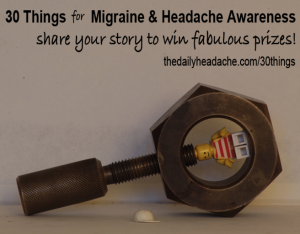This is a reader-submitted story.
1. My diagnosis is: migraine and osmophobia
2. My migraine attack frequency is: 25-28 days per month
3. I was diagnosed in: 2004
4. My comorbid conditions include: obsesity, depression, anxiety, agoraphobia, chemical sensitivity.
5. I take 6 medications/supplements each day for prevention and 3 medications/supplements to treat an acute attack
6. My first migraine attack was: too early to remember
7. My most disabling migraine symptoms are: pain, vertigo, dysphasia, visual changes, severe sensitivity to chemical (synthetic) fragrances and to VOC.
8. My strangest migraine symptoms are: reading thoughts and emotions in others
9. My biggest migraine triggers are: synthetic, chemically based fragrance found in many many personal care (think- other people) and cleaning products (think- anywhere but my own home), as well as laundry products (think dryer vents).
10. I know a migraine attack is coming on when: my vision is double, blurry or I see spots or glow-worms at the side of my peripheral vision, or I mix up words/can’t find word, or I get immediate piercing pain upon exposure to fragrance.
11. The most frustrating part about having a migraine attack is: trying to decide what to do, how to handle, when I am unable to think straight.
12. During a migraine attack, I worry most about: whether it is causing permanent brain damage.
13. When I think about migraine between attacks, I think: What does “between attacks” mean?
14. When I tell someone I have migraine, the response is usually: “Oh I get those too, did you try…..(fill in any medication, remedy, etc.)”
15. When someone tells me they have migraine, I think: I hope it’s only episodic and they are doing what they can to prevent it becoming chronic.
16. When I see commercials about migraine treatments, I think: Someone’s making a buck.
17. My best coping tools are: social media, family, spiritual practice, yoga.
18. I find comfort in: my garden, cats, grandson.
19. I get angry when people say: “It’s only a little (perfume)”, or “It’s all natural (fragrance)”. To me it doesn’t matter, I’m sensitive to very small amounts of chemicals.
20. I like it when people say: How can I become fragrance free so I can be your friend.
21. Something kind someone can do for me during a migraine attack is: bring me some soup, and/or clean the cat box.
22. The best thing(s) a doctor has ever said to me about migraine is: Haha, my neurologist once said that when I do yoga inversions it makes my brains “slosh around” in there (he was joking to try and cheer me up. I was upset because I’d just been triggered during my Iyengar yoga class for the first time in 11 years of practice.
23. The hardest thing to accept about having migraine is: I had to give up my career and I’m unable to date.
24. Migraine has taught me: That really all we have is our inner lives, and that inner life can strengthened through pain.
25. The quotation, motto, mantra, or scripture that gets me through an attack is: “The more difficult the conditions, the more productive the Work, as long as one remembers the Work.” This quote is an aphorism of G.I. Gurdjieff and is about the Sacred Work (on One’s Self) that he taught.
26. If I could go back to the early days of my diagnosis, I would tell myself: Take this very seriously and do everything you can to manage it to prevent it becoming chronic.
27. The people who support me most are: my Sister and my Daughter.
28. The thing I most wish people understood about migraine is: I have symptoms all the time (sensitive) even though I might look okay and I don’t always tell people how dizzy, pained, etc. I am.
29. Migraine and Headache Awareness Month is important to me because: there is always new information from the blogs, social media, and the conference.
30. One more thing I’d like to say about life with migraine is: Everyone who has migraine should take great care to eliminate synthetic chemical fragrance from their environment. The ingredient “fragrance” (read the label) is a potpourri of petrochemicals that are not disclosed to the consumer. many of them have been found to be NEUROTOXIC as well as carcinogenic and causes of ashthma attacks, COPD, dermatitis, etc.
 Reader-submitted stories solely represent the personal point of view, experience, and opinion of the author, not of The Daily Headache or Kerrie Smyres. Follow this link to learn how to share YOUR 30 Things about living with a headache disorder.
Reader-submitted stories solely represent the personal point of view, experience, and opinion of the author, not of The Daily Headache or Kerrie Smyres. Follow this link to learn how to share YOUR 30 Things about living with a headache disorder.
